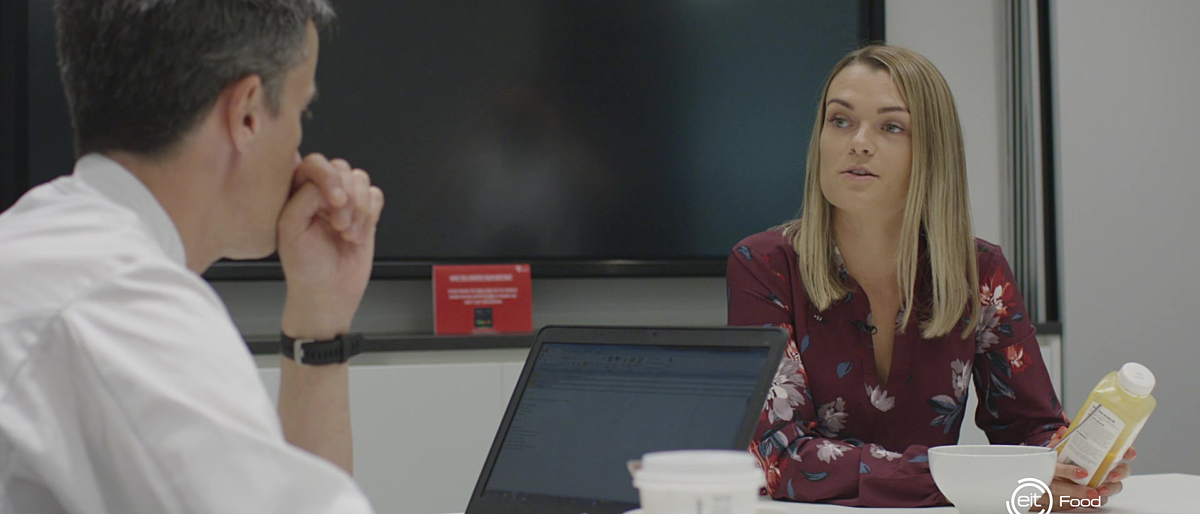
Discover a Day in the Life of a Nutritionist
In this blog, we explore what a career as a nutritionist involves with a registered nutritionist working in the UK.
Our EIT Food Day in the Life series is an educational resource aimed at young people and professionals who are interested in the agrifood job market. We profile a wide range of careers in the agrifood sector, interviewing professionals to find out what their job is like, why it is important, and how you could take up the profession.
You will learn:
- What a typical day is like as a nutritionist
- The main responsibilities of a nutritionist
- Why this industry matters to our wider food system
- How you can take up this career path
Meet Hannah Baugh, a registered nutritionist based in England, UK.
She tells us what life is like working as a nutritionist, and how you can train to become one too.

What does a typical day as a nutritionist involve?
Hannah’s role involves working with clients such as chefs and restaurant owners to create menus that offer healthy and tasty meals for their customers. Whilst it’s important that Hannah understand the types of foods that the client wants to work with, she recommends how to use healthy ingredients that customers will enjoy.
When Hannah is not preparing menus for her clients, she is often spending time in the kitchen with the development team creating new dishes:
“We like to keep our menus current and interesting, so I work with [the development team] developing new recipes, basing them on things that are on trend, and we know our customers want to eat, whilst trying to make them nutritionally balanced and interesting.”

Why is nutrition an important industry to work in? What are the biggest challenges in the sector?
Hannah believes nutrition is important because food is such an essential part of life for everyone:
“The whole point of food is that it is fuel for your body. It can help to prevent illness and disease and it helps you to feel the best you can feel. Eating the right food really does have an impact on everything, from how well you sleep, to how much energy you have through the day, to how much you are able to concentrate.”
Whilst eating the right food is essential for us to live a healthy and fulfilling life, there are challenges with ensuring people have access to healthy food and are educated about a healthy diet. One of the main challenges emerging in recent years is the increase in incorrect information about the nutritional content of different food products and ingredients. There is also a tendency for unhealthy food products to be heavily promoted, which can lead to a rise in unhealthy eating habits.
The spread of misinformation can even manifest itself in the clients that Hannah works with. She explains:
“When you come up against a customer or client who is very headstrong about what they think they want, you have to try and win them round to your way of thinking. [Sometimes] they are not aligned with the government requirements, or [they do not understand] what a balanced diet should look like and the kinds of foods their client should be eating.”
Ultimately, encouraging people to eat healthy diet is both the greatest challenge and most rewarding element of being a nutritionist.

What projects does a nutritionist work on? For example, what are you working on at the moment?
There are a wide range of tasks and projects that Hannah works on, and she emphasises that her personal interest can often determine what she works on.
Recently, Hannah has been spending time going into schools and hosting workshops, to educate children about healthy eating. This is one of the most enjoyable parts of Hannah’s job, because she feels like she is making a positive difference to children’s lives, by helping them to understand different food groups and why they are an important part of their diet.
“It’s amazing [because] you get to influence those young, excited children.”
However, Hannah also acknowledges that there are elements of the job which can be challenging. For example, she often has to create a menu which meets a specific budget for her client, yet the menu must deliver on taste for the consumer and include a balance of healthy ingredients. As Hannah explains:
“Likewise get the very serious end of the situation where you are working with clients on menus that will feed thousands of people, so you have to get it right, you have to meet budgets whilst meeting government guidelines on what you can and can’t serve.”
Despite the challenges associated with her job, Hannah enjoys the responsibility of creating menus that will feed lots of people and being able to educate people about how to use different healthy foods and ingredients.

How can I get involved in this area? What pathways are there into your role?
There are multiple routes into becoming a nutritionist, however the main one involves going to college or university. To become a nutritionist, it is important that you acquire the knowledge necessary to advise people on health and nutrition. As Hannah explains,
“Ideally, the pathway to becoming a nutritionist you need a university degree. If you don’t fancy the university route there are other courses that you can take, but it might take you a little bit longer to get your accredited title.”
After you have received the appropriate accreditation, “[In the UK] you can sign up to the UK voluntary register for nutritionists, which gives you the proof that you have studied, and you have the correct knowledge base to be able to work in the industry.”
However, since the field of nutrition is so varied and the number of places you can work is expansive, “you do have to work quite hard to find the job role you’re interested in, but there are plenty of options.”

What is the best part of the job?
For Hannah, the social impact of her job as a nutritionist is the most important thing:
“The best part of my job is helping people, whether it is working with individual clients that need something to help improve their health perhaps, and likewise with children, we know that if we are putting a delicious and nutritious meal on their tables at lunchtime, it is going to help them learn better in the afternoon.”
Hannah sums up being a nutritionist in three words:

About EIT Food’s Day in the series
EIT Food’s Day in the Life Series is a video series that explores the variety of careers that our agrifood system has to offer. The aim of the series is to raise awareness of the range of high-skilled and highly rewarding jobs that the food and farming sector has to offer and inspire younger generations to consider one of these careers for themselves.
More blog posts by EIT Food West

Making f!sh from microalgae and mushroom roots





